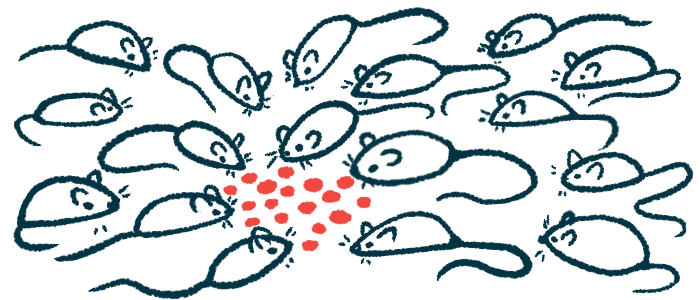Treatment With Zinc-finger Proteins Shows Promise in Huntington’s Mice
ZFPs found to improve behavior, extend survival in preclinical study

Neuron-targeted treatment based on zinc-finger DNA-binding proteins — called ZFPs — was found to lower brain levels of mutant huntingtin (mHTT) protein in a Huntington’s disease mouse model.
The zinc-finger proteins rescued behavioral deficits and extended survival in these mice, the study demonstrated.
ZFPs are among the most abundant proteins, and are involved in several processes, including the regulation of gene activity. In this study, the ZFPs were designed to suppress the production of mHTT.
Notably, earlier intervention, before the formation of toxic mHTT clumps, was more effective at improving behaviors than later treatment, despite both approaches being implemented before symptom onset.
The study, “Neuronal and astrocytic contributions to Huntington’s disease dissected with zinc finger protein transcriptional repressors,” was published in the journal Cell Reports and conducted by researchers at UCLA.
Researchers: findings support development of zinc-finger proteins
Additional experiments by the team revealed that disease-associated neuronal damage contributes more to Huntington’s development than the dysfunction of neuron-supporting astrocytes.
Overall, the findings support the further development of ZFPs for effective mHTT lowering as a potential Huntington’s treatment, according to the researchers.
“Although speculative for human [Huntington’s disease] adaptation at this point, a potentially once-only treatment paradigm to correct disease course portends an attractive potential therapeutic candidate,” they wrote.
Our findings support translational refinement and development of ZFPs
In Huntington’s disease, defects in the HTT gene lead to the production of an abnormally long huntingtin protein, which is thought to form toxic clumps, or aggregates, throughout the body. These clumps, in turn, cause the disease’s symptoms — typically, uncontrolled movements, loss of thinking ability, and psychiatric problems.
However, the disease mainly affects the brain and spinal cord, with the striatum, a brain region involved in motor and reward functions, being particularly targeted.
The two most abundant cell types in the brain are neurons, or nerve cells, and star-shaped cells called astrocytes. In people with Huntington’s, mutant HTT clumps can be found in both cell types.
“But how dysfunction in each of these cell types contributes to [Huntington’s features] has not been directly explored [in a living organism],” the researchers wrote.
This type of knowledge “is necessary to elucidate causal disease-driving cellular mechanisms and to identify therapeutic opportunities,” they wrote.
To address this knowledge gap, the team generated a modified and harmless virus that carried a gene containing the instructions to make zinc-finger proteins. These ZFPs were designed to suppress the activity of the mHTT gene, specifically in either neurons (N-ZFP) or astrocytes (A-ZFP).
In a mouse model mimicking juvenile Huntington’s, a more rapidly progressing condition than the more common adult-onset form, the researchers found mHTT aggregates in the striatum at 3 months of age. About 98% of neurons and 38% of astrocytes contained mHTT aggregates.
When either ZFP-containing virus — targeting neurons or astrocytes — was injected directly into the striatum of these mice at age 4 weeks, the levels of mHTT clumps were significantly reduced, by at least 80%, in the corresponding cell types. There were no effects on the levels of healthy HTT.
Tracking the mice over time
Nearly two months (seven weeks) later, the impact of mHTT lowering in neurons or astrocytes was re-examined. The researchers now measured Huntington’s-associated changes in gene activity, or differentially expressed genes (DEGs).
A-ZFP mostly reversed the disease-associated gene activity profile in astrocytes, while N-ZFT, “unexpectedly, not only showed efficacy in restoration of neuronal DEGs but also had a restorative impact on astrocyte DEGs,” the team wrote.
In addition, 64% of DEGs in astrocytes were downstream of neuron dysfunction, while only 15% of the neuronal DEGs were downstream of astrocyte impairment, “implying that perhaps astrocytes are responding to greater neuronal dysfunction,” the researchers wrote.
Major pathways rescued in astrocytes by A-ZFP were related to cholesterol and metabolism, wheras major pathways rescued in neurons with N-ZFP were associated with regulation of neuronal activity, neuron communication, and cellular signaling.
Similar effects were observed with N-ZFP in a second mouse model of Huntington’s that is expected to produce similar amounts of healthy huntingtin protein to humans, in addition to mHTT.
Particularly, N-ZFP treatment was found to reduce mHTT levels by about 55% and to effectively attenuate Huntington’s-related DEGs in both neurons and astrocytes.
Next, researchers tested the behavioral impact of brain-wide administration of the ZFP-based treatment in the juvenile-onset Huntington’s mouse model at 4 weeks of age. They first found that N-ZFP and A-ZFP were detected throughout the brain and lowered mHTT aggregate levels by 70–80% in their corresponding cell types.
N-ZFP reduced Huntington’s-associated abnormal behaviors by about 89%, while A-ZFP was associated with a more modest behavioral improvement, of 26%, that generally did not reach statistical significance.
Notably, when the mice were treated only at the age of 7 weeks, only about 37% of behaviors were rescued, emphasizing the importance of earlier treatment to obtain optimal therapeutic effects.
Because mHTT aggregates are already formed by 7 weeks of age in mutant mice, “ZFP-mediated mHTT lowering is most effective before aggregate formation,” the researchers wrote.
Moreover, N-ZFP treatment delayed the onset of some disease-associated behaviors by more than one month and prolonged the animal’s survival by about two months.
These findings highlight that “appropriately timed and early presymptomatic mHTT lowering can offset subsequently expected molecular, cellular, and behavioral [Huntington’s disease features] in mice,” the researchers wrote.
“It is not possible to predict clinical success for humans from studies in mice alone, but our findings support translational refinement and development of ZFPs for neuronal mHTT lowering, together with pharmacological and cell-replacement strategies to restore astrocytic [healthy] support for [Huntington’s disease],” the team added.
Their ZFP-based approaches also dissected the “contributions of astrocytes and neurons” to Huntington’s disease in animal models, the researchers noted, adding that these approaches may be used in “other neurodegenerative diseases in which both cell types have been implicated for over a century.”








